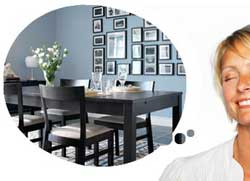Ikea has moved. This is probably one of the most talked about topics over the
past few weeks, and although for many this may be news, the fact that there is
an Ikea (or "Yi Jia," Ikea's Chinese name which literally means "comfortable
home") in Beijing is most definitely not.
Ikea has become a household name in Beijing during its seven years' residence
in the capital. The store's old building on the Third Ring Road has and will
continue to be a signpost for many to give directions.
The new Ikea, at the northwest corner of Siyuan Flyover on the North Fourth
Ring Road, covers an area of 43,000 square metres, making it the Second largest
Ikea in the world after its own headquarters in Stockholm.
|

A Peking Opera performer waits for the opening
of IKEA store in Beijing April 12, 2006. IKEA now operates three stores in
mainland China. The company has invested about $100 million in its newest
store, bringing its global total to just over 230 stores. The Beijing
store is the retailer's second-largest worldwide, smaller only than its
flagship store in the Swedish capital of Stockholm. [Reuters]
|
On the opening day, April 12, the store
received a record 70,000 visitors and sold more than 6,500 hotdogs at its food
centre. Its magnetic effect on traffic was instantaneous. At 5 pm that day,
hundreds of driving customers spent around 20 minutes to get their cars out of
Ikea's underground parking lots, which has three levels and is spacious enough
to take 1,200 cars but has only one narrow exit.
The waiting continued when they tried to squeeze their cars onto the Fourth
Ring Road, where the traffic had almost frozen.
According to Zhu Shangqi, a mother with an 18-month-old boy who paid a visit
to Ikea that day, it took her around 65 minutes to drive home from Ikea, only
six kilometres away.
The situation didn't get any better the second day when again thousands of
visitors, at least 30,000, according to Chen Yue, marketing manager of Ikea
Beijing, held up the traffic to such an extent that traffic police were summoned
and local traffic radio programmes had to warn drivers to stay away from the
area.
 Why Ikea?
Why Ikea?
Why do people care about Ikea? Why all the fuss?
When Ikea first opened in Beijing in 1999 and sold mostly highly priced
imported furniture and housing utensils, the Swedish furniture retailer
attracted mostly high-income and design-conscious social elites.
Soon the situation started to change, partly because of the burgeoning
homeownership in China over the recent years. Over the past eight years, China
has seen a huge surge in homeownership as Chinese authorities have done away
with state-allocated housing and subsidized rentals. Since many apartments are
typically empty shells sold without paint, lighting or even flooring - a
practice called "maopi," or semi-furnished - the market for home furnishings has
taken off.
Having almost no experience in furnishing, most new homeowners have found
Ikea a perfect training centre. As home furnishing consumers tend to buy by
function rather than by style, Ikea shows Chinese consumers how to make the most
of their living space, gives them hints on how to mix and match colours, designs
and concepts and make choices.
The concept has been well received.
"Others offer affordable furniture," said Bobby Wang, a Chinese American in
his late 20s who came back to Beijing for work five years ago. "But there is no
one else who offers the whole concept all under one roof."
Wang reveals joyfully that with one purchase from Ikea, he set up a home in
Beijing within two days, all to his taste and at his convenience.
More people, mainly young white-collar workers lured by its stylish design,
throng to Ikea, though mostly to look rather than buy. For many, Ikea's image in
its early years in China was super good design plus super unreasonable price.
Accusations like "how Ikea can sell a colourful paper box at 59 yuan
(US$7.2)?" abounded as such spending was impossible for most people at that
time. Most Chinese consumers don't think a paper box should be that dear.
The high pricing kept people from buying, but not from copying. It was not
unusual to see people bring along a measuring tape and a carpenter to Ikea. For
many, this was an affordable alternative to get a cheaper yet more endurable and
Ikea-like home.
Yu Dan, a reporter with a local musical weekly, claims herself a die-hard
Ikea fan. Yu said she fell in love with Ikea four years ago when she and her
boyfriend furnished their apartment which they now, as husband and wife, call
home. "We get a lot of inspiration from Ikea," Yu revealed. "It has made our
furnishing much easier and we love the style, the way it makes use of space."
She admitted that at first she custom-made a cabinet after seeing an Ikea
piece, for the cost's sake. She was unsatisfied with the outcome. "It looks
similar to the prototype, but not exactly," she said.
(For more biz stories, please visit Industry Updates)